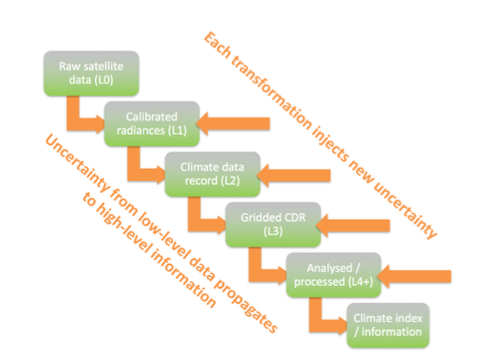Key point: you are invited to read my ‘green paper’ about the influence FIDUCEO could (I would hope, should) have beyond the project itself.
Readers of this blog will know that in FIDUCEO we are addressing the application of measurement science to historic series of satellite sensors, and thereby will derive new uncertainty-quantified climate data records (CDRs).
However, we are convinced that the “Earth observation metrology” we are developing has a wider range of applications. Most obviously, to current and future satellite missions. The best time to build the model of radiance uncertainty for a sensor is during the mission development, since, as we have shown in FIDUCEO, deep understanding of the instrument and pre-launch calibration is needed. Yet, in current practice, the deep understanding available during mission development is (usually) not translated into useful uncertainty information in the ‘level 1’ products — and therefore cannot be exploited in the geophysical products (including CDRs) later derived. In part, this is probably for lack of an “Earth observation metrology” framework for capturing and communicating the (admittedly complex) understanding of sources of uncertainty. But in FIDUCEO, we now have that framework.
For sure, there are obstacles (see earlier blog), but also an opportunity.
Furthermore, the idea that knowledge of uncertainty should be propagated from level 1 (FCDRs containing radiances) to CDRs in order to understand the limitations of the latter also applies to higher level information derived from CDRs — as might be used directly by a decision maker. Uncertainty (how sure are we?) and traceability (can we prove it?) are key questions in real-world, down-stream applications, especially where questions of liability may arise.
These comments are expanded at greater length in a discussion paper I wrote at the request of FIDUCEO’s technical officer at the commission. It includes ideas for more research that it will be exciting to pursue, and will have real implications for space agencies and Earth observing scientists. You are invited to read it.

